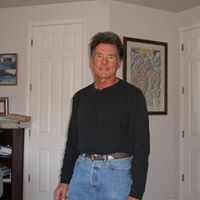James H Parry
age ~83
from Pacific Grove, CA
- Also known as:
-
- James Howard Parry
- James A Parry
- James N Parry
James Parry Phones & Addresses
- Pacific Grove, CA
- Ramah, NM
- Pescadero, CA
- Truth or Consequences, NM
- Oxnard, CA
- Boulder Creek, CA
Work
-
Company:Golden realty group
-
Address:101 So. River Street, Santa Cruz, CA 95060
-
Phones:321 777-4949
-
Position:Ceo
-
Industries:Real Estate Agents and Managers
Isbn (Books And Publications)
-
The Discovery
view source -
Author:James Parry
-
ISBN #:0690011660
-
Coast And Countryside Handbook
view source -
Author:James Parry
-
ISBN #:0707803063
-
Living Landscapes: Heathland
view source -
Author:James Parry
-
ISBN #:0707803489
-
The Living Coast: Past, Present And Future
view source -
Author:James Parry
-
ISBN #:0707803594
-
Irises
view source -
Author:James Parry
-
ISBN #:0707803675
-
The True Anti-Pamela (1741)
view source -
Author:James Parry
-
ISBN #:0824013093
Lawyers & Attorneys
License Records
James F Parry
License #:
E-4295 - Expired
Category:
Engineering Intern
Us Patents
-
Videoconferencing Using Distributed Processing
view source -
US Patent:6603501, Aug 5, 2003
-
Filed:Nov 21, 2000
-
Appl. No.:09/721547
-
Inventors:James H. Parry - Los Gatos CA
See-Mong Tan - Half Moon Bay CA -
Assignee:Onscreen24 Corporation - Sunnyvale CA
-
International Classification:H04N 714
-
US Classification:348 1412, 348 1411, 348 1413
-
Abstract:A video teleconferencing system and method transfers video teleconferencing signals from a sender to a receiver. The sender determines decision information based on internal or external factors. The sender may or may not generate a video teleconferencing signal depending on the content of the decision information. If generated, the video teleconferencing signal is encoded at the sender and sent to the receiver. Each sender includes at least one memory module for storing the decoded signal, each memory module is one group. The sender updates its memory module with a copy of each sent video teleconferencing signal. The receiver decodes the signal and presents the signal to the user of the receiver. The receiver stores a copy of the signal in a memory module identified with each specific sender.
-
Apparatus And Method For Controlling An Acoustic Echo Canceler
view source -
US Patent:6650701, Nov 18, 2003
-
Filed:Jan 14, 2000
-
Appl. No.:09/483601
-
Inventors:Peter C. Hsiang - Cupertino CA
James H. Parry - Los Gatos CA -
Assignee:VTEL Corporation - Austin TX
-
International Classification:H03H 730
-
US Classification:375232, 375285
-
Abstract:A method and associated apparatus for controlling an acoustic canceler (âAECâ) are disclosed. Prior to passing audio signals to the AEC, a distortion detector is used to determine if the signals are distorted. If so, the AEC does not adapt is filter coefficients to the distorted signals. This technique improves the AECs ability to adapt its filter coefficients to subsequent undistorted signals. For example, near-end or far-end audio signals above a predetermined threshold value are detected by a distortion detector which disables adaptive filter control logic so that distorted signals do not result in generation of erroneous filter coefficients.
-
Adaptive Video Decoding And Rendering With Respect To Processor Congestion
view source -
US Patent:6728312, Apr 27, 2004
-
Filed:Apr 13, 2000
-
Appl. No.:09/548570
-
Inventors:Paul H. Whitford - Santa Clara CA
James H. Parry - Los Gatos CA
See-Mong Tan - Half Moon Bay CA -
Assignee:Forgent Networks, Inc. - Austin TX
-
International Classification:H04N 712
-
US Classification:37524001
-
Abstract:Disclosed is a method and system for reducing audio artifacts and/or avoiding invalid reference memory in a compressed video decoder due to processor congestion. The system and method includes decoding compressed frames of video data, and decoding compressed frames of audio data. The system and method determines whether audio data can be generated without audio artifacts. If it is determined that audio can be generated without audio artifacts, then images corresponding to the decoded frames of video data, respectively, are subsequently displayed. If however it is determined that the audio can not be generated without artifacts due to processor congestion, images are displayed and redisplayed while processor power is shifted to decoding frames of audio data.
-
Method And Apparatus For Detecting Processor Congestion During Audio And Video Decode
view source -
US Patent:6751404, Jun 15, 2004
-
Filed:Apr 13, 2000
-
Appl. No.:09/548898
-
Inventors:Paul H. Whitford - Santa Clara CA
James H. Parry - Los Gatos CA
See-Mong Tan - Half Moon Bay CA -
Assignee:Forgent Networks, Inc. - Austin TX
-
International Classification:H04N 591
-
US Classification:386100, 386104
-
Abstract:Disclosed is a method and system for detecting processor congestion during decompression of a stream of video and audio data. The system and method includes a processor receiving and decoding a first frame of audio data in accordance with an audio decode software algorithm. The processor generates a first audio time stamp ATS indicating the time at which the processor finishes decoding the first frame of audio data. Subsequently, the processor receives and decodes a second frame of audio data in accordance with the same audio decode software algorithm and generates a second audio time stamp ATS indicating the time at which the processor finishes decoding the second audio data frame. The first audio time stamp ATS is added to a predetermined amount of time T, the result of which is compared with ATS. T, in one embodiment, is the time it takes a speaker to generate audio corresponding to a decoded frame of audio data. If ATS is later in time than (ATS +T) by a predetermined amount TMIN, a signal is generated indicating that the processor is not decoding received audio frames fast enough due to processor congestion.
-
Communications System And Method Utilizing Centralized Signal Processing
view source -
US Patent:7206404, Apr 17, 2007
-
Filed:May 9, 2005
-
Appl. No.:11/124772
-
Inventors:James H. Parry - Saratoga CA, US
Peter Hsiang - Cupertino CA, US -
Assignee:Tandberg Telecom AS - Lysaker
-
International Classification:H04M 9/08
-
US Classification:37940601, 37940608, 381 941, 381 95
-
Abstract:A communications system and method performs centralized signal processing on received audio signals. A plurality of terminals are coupled to a processing switch via links. The terminals can be, for example, dedicated speakerphones, desktop handsets, or personal computers with audio capabilities. The links can be wired or wireless, can carry analog or digital signals, and can be shared with other users in a network. The switch receives the audio data from the terminals, processes the data according to desired acoustical procedures, creates one or more output mixes, and provides the output mixes to the appropriate terminals. The operation of the processing switch is controlled by a communications support module (CSM) which can receive, process, and send data to/from multiple terminals simultaneously. The CSM receives audio signals from the terminals. The CSM uses stored room models holding room model information including data and/or filters representing the acoustic properties of the terminal and/or the environment surrounding the terminal to produce the audio signals.
-
Distortion Compensation In An Acoustic Echo Canceler
view source -
US Patent:7277538, Oct 2, 2007
-
Filed:Oct 4, 2005
-
Appl. No.:11/243236
-
Inventors:James H. Parry - Los Gatos CA, US
-
Assignee:Tandberg Telecom AS - Lysaker
-
International Classification:H04M 9/08
-
US Classification:37940601, 37940606
-
Abstract:An audio communications system has an acoustic echo cancellation (AEC) module. The AEC module receives a digital signal sent to a loudspeaker and a digital signal received from a microphone. The signal received from the microphone contains an echo of the signal played through the loudspeaker. The loudspeaker signal is processed by an audio generation module (AGM) that models substantially nonlinear distortions that can occur while producing the signal played through the loudspeaker. The AGM includes a modeling path comprised of one or more distortion modules. Each distortion module receives digital samples as input, modifies the samples to model a form of distortion, and outputs the modified samples. The output of the AGM is provided to an acoustic echo estimation (AEE) module that uses adaptive algorithms to compensate for substantially linear changes in the echo characteristics of the environment in which the loudspeaker and microphone are located.
-
Structure And Method For Conversation Like Rendering For Echo Reduction Without Loss Of Information
view source -
US Patent:8027462, Sep 27, 2011
-
Filed:Aug 11, 2006
-
Appl. No.:11/502943
-
Inventors:James H. Parry - Pacific Grove CA, US
-
International Classification:H04M 1/00
-
US Classification:37940604, 37940607
-
Abstract:A method for conversation like rendering of a stored audio information stream determines a first location in the stored audio information stream. The first location represents a point in time when the sound detection flag became active. The method next moves from the first location to a second location in the stored audio information stream. The second location is selected based upon a criterion to make playback of the stored audio information stream appear like actual conversation. Finally, the stored audio information stream is rendered starting with audio information stored at the second location.
-
Structure And Method For Echo Reduction Without Loss Of Information
view source -
US Patent:8422663, Apr 16, 2013
-
Filed:Jun 24, 2011
-
Appl. No.:13/168762
-
Inventors:James H. Parry - Pacific Grove CA, US
-
International Classification:H04M 9/08
H04M 1/00
H04B 1/38
H04B 3/20
H04L 5/16 -
US Classification:37940607, 37940602, 455570, 370288, 370296
-
Abstract:An echo reduction method stores a received audio information stream. A sound detection flag is activated following detection of locally generated sound. Output based on the received audio information stream is muted in response to the activating the sound detection flag. Rendering status of the received audio information stream is saved, in response to the activating the sound detection flag, to reduce loss of audio information. At least a portion of the stored received audio information stream is rendered following inactivation of the sound detection flag.
Resumes

James Parry
view sourceLocation:
United States
Medicine Doctors

James R. Parry
view sourceSpecialties:
Cosmetic Surgery, Facial Plastic Surgery
Work:
Parker Skin & Aesthetic Clinic
3737 Park East Dr STE 109, Beachwood, OH 44122
216 464-7333 (phone), 216 464-2696 (fax)
3737 Park East Dr STE 109, Beachwood, OH 44122
216 464-7333 (phone), 216 464-2696 (fax)
Education:
Medical School
Lake Erie College of Osteopathic Medicine, Erie Campus
Graduated: 2003
Lake Erie College of Osteopathic Medicine, Erie Campus
Graduated: 2003
Procedures:
Hearing Evaluation
Skin Tags Removal
Skin Tags Removal
Conditions:
Abdominal Hernia
Acute Sinusitis
Allergic Rhinitis
Appendicitis
Breast Disorders
Acute Sinusitis
Allergic Rhinitis
Appendicitis
Breast Disorders
Languages:
English
Description:
Dr. Parry graduated from the Lake Erie College of Osteopathic Medicine, Erie Campus in 2003. He works in Beachwood, OH and specializes in Cosmetic Surgery and Facial Plastic Surgery. Dr. Parry is affiliated with Hillcrest Hospital.
Name / Title
Company / Classification
Phones & Addresses
CEO
Golden Realty Group
Real Estate Agents and Managers
Real Estate Agents and Managers
101 So. River Street, Santa Cruz, CA 95060
Director
Parrys Investments Inc
Flickr
Classmates

James Parry
view sourceSchools:
Fairfield College Preparatory School Fairfield CT 1969-1973
Community:
Lawrence Caseria, David Underhill, Domenic Carlucci

James Parry
view sourceSchools:
Oakwood Elementary School Salt Lake City UT 1971-1972, Bonneville Junior High School Salt Lake City UT 1972-1975
Community:
Jeff Thornton, Carla Renak

James Parry
view sourceSchools:
Eastern State High School Charleston IL 1956-1960
Community:
Sandra Dunevant, Kimberlee Swartz, Shirley Moen

James Parry (James Parry)
view sourceSchools:
King George V High School Hong Kong IL 1998-2002
Community:
Glenda Case, Raazia Bokhari, Sandralyn Eby, George Grout

James Lee (Parry)
view sourceSchools:
Texas Tech University School Lubbock TX 1960-1964
Community:
Tina Hines

James Parry
view sourceSchools:
Middlesex County Vo-Tech School Perth Amboy NJ 1965-1969
Community:
Barry Blaes, David Kau, Wilfred Aguiar, Joseph Angelis, Robert Falk, John Kerchner, George Strand, Steve Krompacs, William Daniels, Paul Mundy

James Parry | Perth Amboy...
view source
James Parry, Linden High ...
view source
James Bartlett Parry
view source
Karlyn James Parry
view source
James F. Parry
view source
James R Parry
view source
James Parry
view source
James Edward Parry
view source
James A. Parry
view source
James Brody Parry
view sourceGoogleplus

James Parry
Work:
My Wife - General
Self - Handyman
Self - Handyman
Education:
Family Business - Financial Survival, Texas Tech - Accounting, USAF - Auditing
Tagline:
Goat Feeder and Water Trough Cleaner

James Parry
Work:
IKEA (2011-2012)
Education:
Great Sankey High School, Barrow Hall College - Music, Music Tech, Media, Psychology.
About:
I play guitar.
Bragging Rights:
I'm in a band.

James Parry
Bragging Rights:
2 awesome kids and Great girl

James Parry
Relationship:
Single

James Parry

James Parry

James Parry

James Parry
Plaxo

James Parry
view sourcePro Body Parts

Brian James Parry
view sourceStanford North, Kent
Youtube
Myspace

James Parry
view sourceLocality:
Preston (term)/Wokingham (hols), United Kingdom
Gender:
Male
Birthday:
1946
Get Report for James H Parry from Pacific Grove, CA, age ~83
















